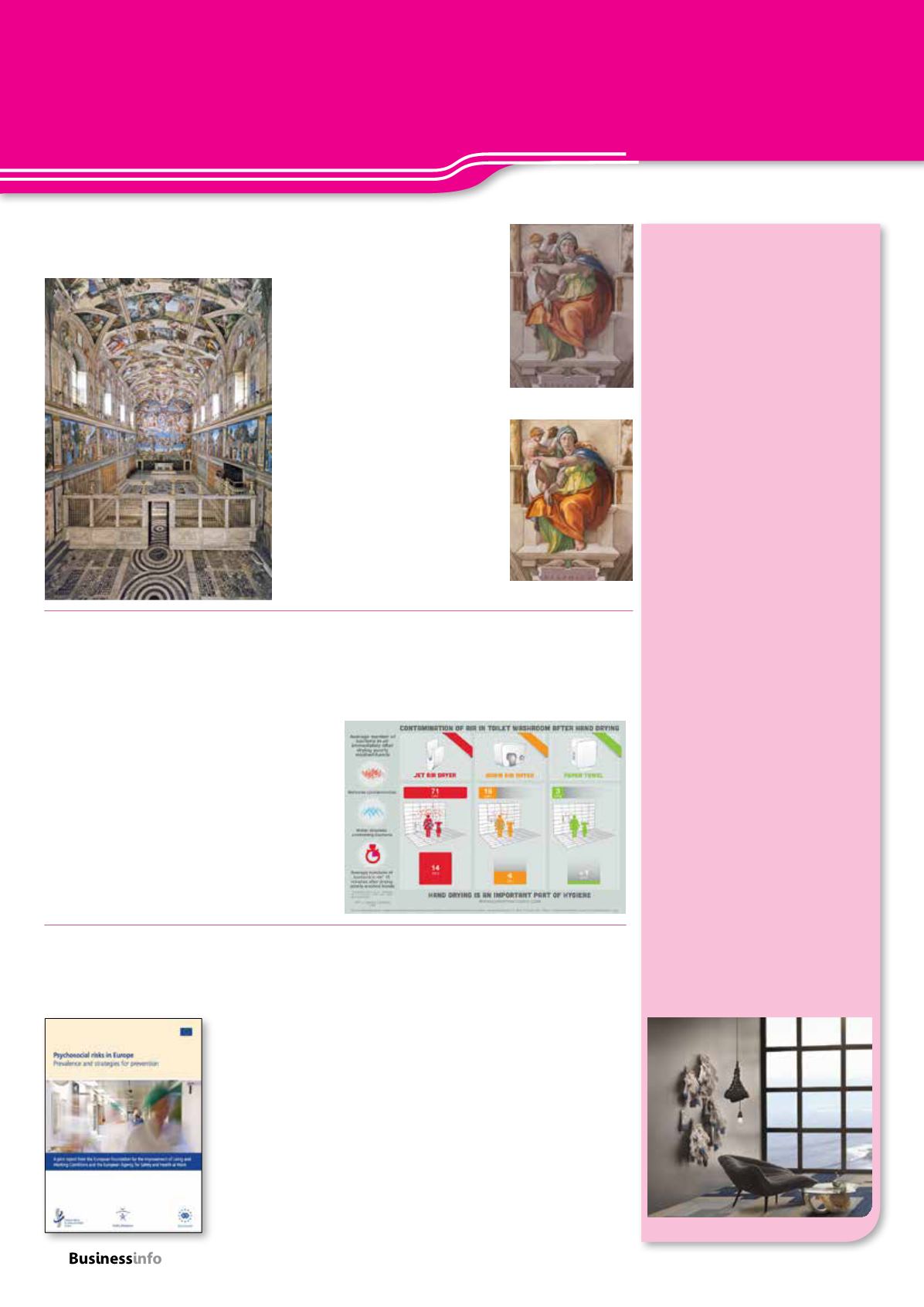
04
magazine
LED lighting is being selected by
more and more businesses as an
energy-saving lighting choice. But,
as Osram’s instalIation in the Sistine
Chapel demonstrates, LED lighting has
many other qualities. Michelangelo’s
masterpiece is now bathed in light
from more than 7,000 LEDs that enable
the 5.5 million people who visit the
chapel every year to see more detail
and brighter colours than ever before.
Despite a five to ten-fold increase in
luminance, the new system consumes
up to 90% less electricity than the
previous lighting system. In addition,
the almost complete absence of
ultraviolet and infrared radiation from
the lighting prevents damage to the
artworks.
Light and nature are key
to well-being
Working in environments with
greenery and sunlight engenders
a 13% higher level of well-being
and makes employees 8% more
productive, a new report shows.
The Human Spaces Report
commissioned by flooring specialist
Interface and led by organisational
psychologist Professor Sir Cary Cooper
looked at the impact of the physical
office environment on employee well-
being across 3,600 office workers in
eight countries throughout EMEA
It found that 55% of EMEA office
employees don’t have access to any
greenery in their working environment
and 42% have no natural light – 7%
have no window in their workspace at all.
Spain reported the highest number
of office employees with no windows
(15%) and the most stressed workforce.
In contrast, Germany and Denmark,
which reported the least number of
workers with no windows (2% and 3%
respectively), had the happiest employees.
Nearly two-thirds (63%) of EMEA
office workers are based in a town or
city centre and spend an average of 34
hours per week in the office. Despite
city dominated lives, the research found
workers have an inherent affinity to
elements that reflect nature.
The top five natural elements EMEA
office workers wish for are:
1
Natural light
2
Quiet working space
3
A view of the sea
4
Live indoor plants
5
Bright colours
Four out of 10 (40%) workers
across EMEA said they would feel most
productive at their own desk in a solitary
office, compared to 31% who said they
would feel most productive at their own
desk in an open plan office.
agenda
Let there be LED light
The European Tissue Symposium (ETS), the
European organisation for tissue producers, is
warning of the health risks of jet and warm air
hand driers after ETS-funded research found
that they could spread bacteria in washrooms.
A study designed by expert medical
microbiologist Professor MarkWilcox of the
University of Leeds and Leeds Teaching Hospitals
compared different hand drying methods and their
potential to spread bacteria from hands into the
air and onto users and bystanders.
Air bacterial counts close to jet air driers were
found to be 4.5 times higher than around warm
air driers and 27 times higher than around paper
towels.
In addition, bacteria remain present in the air
beyond the 15 second hand-drying time, with half
still present after 5 minutes and some still present
15 minutes after hand-drying.
Beware warm air hand dryers, says ETS
One in four European workers feels stressed
One-quarter of workers in Europe report feeling stressed at work all or most of the time, and a
similar proportion say that work affects their health negatively.
A report, published as part of the Europe-wide
HealthyWorkplaces Manage Stress
campaign found
that psycho-social risks, such as monotonous tasks, high work intensity,
tight deadlines, work-life unbalance, violence and harassment from the
public or from colleagues, all contributed to work-related stress.
Psychosocial risks in Europe: Prevalence and strategies for prevention
published jointly by the European Agency for Safety and Health at Work
(EU-OSHA) and the European Foundation for the Improvement of Working
and Living Conditions (Eurofound) provides an overview of psycho-social
risks in European workplaces and explains how to manage them at work
and politically.
Juan Menéndez-Valdés, director of Eurofound, said: “Reducing psycho-
social risks and protecting workers from these risks is critical for allowing
longer working lives and preventing early labour market exits.”
A sea view helps well-being
After
Before


